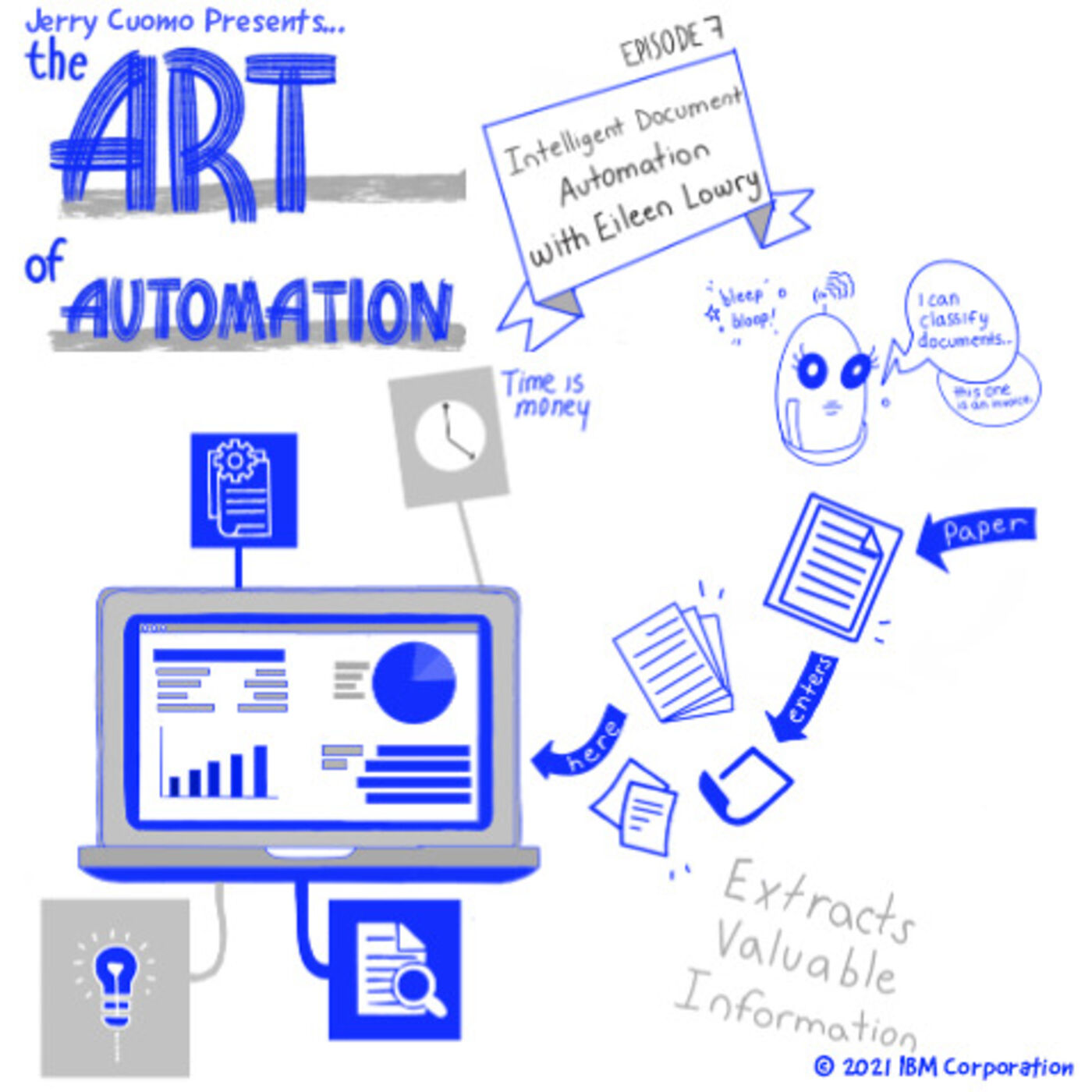Intelligent Document Automation with Eileen Lowry
- 0.5
- 1
- 1.25
- 1.5
- 1.75
- 2
Speaker 1: From IBM Cloud and Cognitive Software, you are listening to The Art of Automation with host Jerry Cuomo.
Eileen Lowry: Hi all. Jerry's not here right now, but don't worry, he's coming and I'll be sure to verify and record his identity on the blockchain when he arrives. I'm Eileen Lowry, Director of Offering Management for Business Automation and I'm excited to talk to you today about automating document processing, which is all aimed at reducing manual work.
Jerry Cuomo: Hey, hey. Thank you Ethan. And ladies and gentlemen, welcome.
Eileen Lowry: Hey Jerry, I already introduced us.
Jerry Cuomo: Eileen?
Eileen Lowry: We're all ready to go.
Jerry Cuomo: You're here?
Eileen Lowry: Oh yeah.
Jerry Cuomo: Oh. Oh, okay. You got here early. So, all right. Well, let's get right to it. Welcome Eileen to the Art of Automation.
Eileen Lowry: Thanks for having me, Jerry.
Jerry Cuomo: Oh, my pleasure. Hey Eileen, so document processing and automation. What are these manually intensive tasks associated with document processing and why are they so difficult to automate?
Eileen Lowry: Well, as you know, Jerry, the concept of automating work is not new. You can go back to the industrial revolution where we've started to introduce machinery to assist with manual labor.
Jerry Cuomo: True.
Eileen Lowry: Various factors forced change then, from creating the first wave of manufacturing. And the same is true actually for document processing. There have been many factors that have contributed to continued manual work. The explosion of digital content has just resulted in so many variations of document formats, layouts, as well as new input channels that have varying quality. And we can't just blame the poor fax machine anymore. You might be in the back of an Uber, right, trying to take a picture on your way to the airport, or you might have poor lighting. In addition, you might actually have information that's inside emails that's important for processing changes to an account or updates to an insurance claim. And this explosion of digital content, there's been existing technology, but those techniques actually can't scale anymore. So a popular technique was to use fingerprints, so you could find that specific place in the document format itself. Or we had this thing called separator sheets, you had a header or barcode to actually identify where there were breaks. But that's also not effective because applications are coming in from all these different channels. Again, email, phone, online forms. So they're just not practical. These are a couple of those factors that just are resulting in more and more manual work.
Jerry Cuomo: All right. That explains it. Now, this is AI powered automation, so how is AI changing the game in the space of document processing?
Eileen Lowry: Yeah, right on. So AI, as you know, it's been coming a long way in recent years. It's been difficult to actually implement. You needed data science skills, thousands of document samples to train models, which takes time in and of itself to collect those documents to get that data. So we have new tools that are called deep learning, where you begin to actually mimic the human brain. They can identify valid contextual patterns to actually gain understanding of unstructured information, like the contents of a document. And then you can apply that learning to things it hasn't seen before, which we like to call transfer learning. So AI plus deep learning now actually enables the processing of complex information sources where it could be trained by a business user with fewer samples, thus enabling the automation of document processing.
Jerry Cuomo: So Eileen, I happen to know, besides your blockchain acumen, you've been doing a lot of work on document processing as you're describing here. So tell us a little bit more, how are you putting it together in IBM automation?
Eileen Lowry: Yeah, so we've been creating a cloud native solution that actually combines AI with deep learning to help eliminate that manual processing. What we do is we classify documents by reading and extracting data from documents, we refine that data and perform automatic enrichments, so you might have a word misspelled that you can automatically correct. But also allowing for that human in the loop where needed because obviously, organizations have different varying levels of business risk. So we want to create quality high output data and apply that to business processes and applications. We've also provided pre- trained models for invoices and utility bills to really help our customers get started faster. Provide them a way to actually process documents very quickly, combine that with some low code tooling so that they can create their applications and get up and running and again, reduce that manual effort.
Jerry Cuomo: So Eileen, why call it automation document processing as opposed to process automation or capture or digital transformation, which is terms that we've been hearing along? Why this term automation document processing?
Eileen Lowry: Yeah. So capture is just this traditional umbrella category, but now with the injection of AI in this space, intelligent document processing is just more appropriate of a category fit. And document processing or automation document processing best captures, no pun intended here, what the new IBM component is and is not. And for IBM, we're really focused, as I've said a few times, on reducing that manual processing of documents and automating work by using AI to classify documents, extract data, really to be able to apply data to workflows and applications. And this really improves the quality of processes actually looking to be automated.
Jerry Cuomo: All right, so you just talked about workflow, and in prior episodes we've talked about RPA. So when you think about process automation, is there a benefit to combining workflow or RPA with the automation document processing that you've been discussing?
Eileen Lowry: Yeah, and as you know Jerry, we've talked often even in our blockchain days about garbage in, garbage out. And so we all know that bad input data results in bad output and bad business decisions, which no one wants to make. So this is really where the automation document processing with RPA or with workflow tools just provides overall greater benefit. The output of automation document processing is high quality, validated, structured, or structured information that really enables RPA bots to scale and have continuous RPA operations. And at the same time, validated extracted data just enables overall better, faster processing of transactions, so there's no manual setup, there's no manual data entry or late validation. We're really bringing validation much earlier into the process so that your workflows can run more seamlessly or even from a straight through processing standpoint. And when you combine all this with dashboards, business users are incredibly empowered to actually uncover patterns and insights and just make more informed decisions, which we all would love to do, and that's a win- win.
Jerry Cuomo: Yeah, Eileen, I'm definitely starting to see the win- win here. Now, can you bring it all together with an example that maybe shows intelligent document processing in a real world situation?
Eileen Lowry: Sure, Jerry. In commercial insurance, time is literally money. What happens is agents submit applications on behalf of their customers to multiple insurance providers for a quote and approval. The first company to respond with a quote often wins the business. The challenge is that in many insurance companies, the quote and approval process requires manual review, entry of application data, reading supporting documentation, making it difficult to actually compete or scale. This also takes away focus from agents that are working on advisory services, which are needed to retain and grow the existing business. Intelligent document processing can automate this process using deep learning to actually read and classify documents, extract the appropriate data. And since it doesn't rely on the location of fields in documents, the AI is smart enough to handle forms it hasn't seen before. And the extracted data is returned in the same format, you have human and loop validation to reduce your risk, and all this data is then complete and accurate. Extracted data can also then be used with workflow, decision technology, or RPA as we talked about earlier, to accelerate the business processing, to produce the quote, right, approve the application and win the business. And as I said before, time is literally money. So this is all great because now you've been able to increase your revenue from a commercial insurance standpoint, more business closed without the need for additional staffing, you're able to improve the customer experience, and they're satisfied and happy because you've increased the processing speeds, and now you can actually focus on your advisory services to retain and grow your existing customer accounts as well.
Jerry Cuomo: Yeah, Eileen, I agree. Time is money and you just nicely illustrated how intelligent document processing can help insurance companies use automation to quickly and responsibly respond to and hopefully win bids, and that's real nice. And ladies and gentlemen, you've been listening to The Art of Automation with guest Eileen Lowry, Director of Digital Business Automation and Intelligent Document Services at IB. And you know folks, given Eileen got here before I did, I really didn't do a proper introduction. So before business automation, Eileen alluded to a few times during this podcast that she's a founding member of the IBM blockchain team where she led our offering strategy, including the work we did and are doing with Hyperledger technology and open source. Eileen knows how to make things happen and she draws on a real wealth of impressive background in product management, merges and acquisitions, business development, financial planning, and software development. And I have the pleasure to work with Eileen today on all things automation. Eileen, where can our listeners go to hear more about automation and intelligent document processing?
Eileen Lowry: Yeah, they can go right on our website, ibm.com/ automation.
Jerry Cuomo: Well, that's it. And once again, I want to thank you Eileen, and thank you all for listening. This is Jerry Cuomo, IBM fellow and Chief Technology Officer of IBM Automation, and I'm looking forward to talking to you again soon.
DESCRIPTION
Jerry is joined by IBM Director of Digital Business Automation and Intelligent Document Services, Eileen Lowry. They discuss why document processing is so manually intensive and what makes it so difficult to automate. Eileen describes how AI/Deep Learning can mimick the human brain to understand the unstructured information found in an enterprise's wide variety of documents. She shares an example from the insurance industry that shows the enormous business value of Intelligent Document Automation.
Art by Caroline Scholer.








